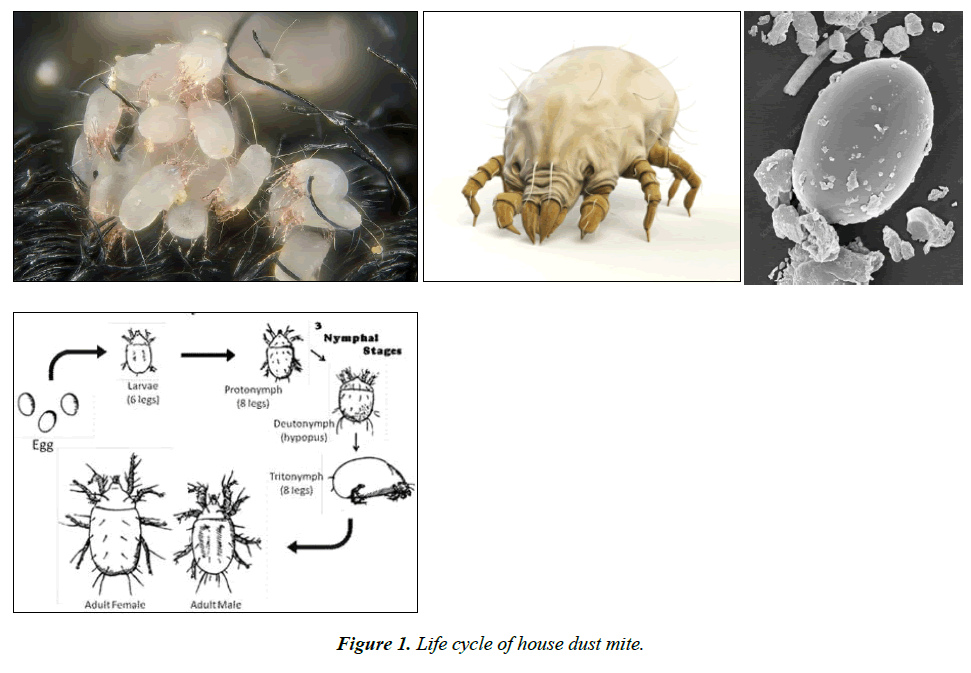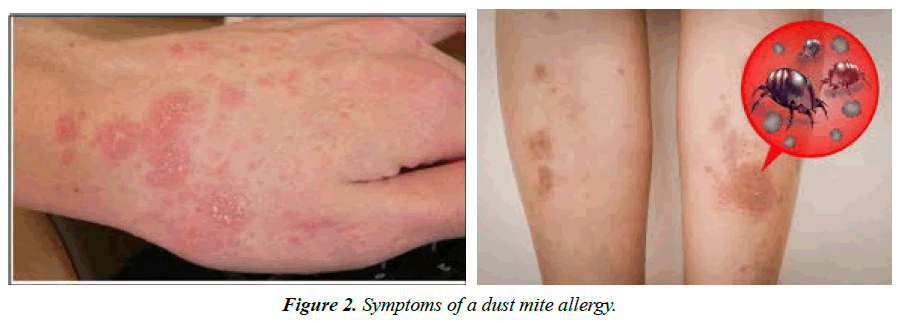Commentary - Journal of Clinical Respiratory Medicine (2022) Volume 6, Issue 1
Biology of house dust mites as an allergens and methods for their control.
1Department of Medical Entomology & Vector Control, School of Public Health, Tehran University of Medical Sciences, Tehran, Iran
2Department of Chemical Pollutants and Pesticides, Institute for Environmental Research, Tehran University of Medical Sciences, Tehran, Iran
- *Corresponding Author:
- Hassan Vatandoost
Department of Medical Entomology & Vector Control
School of Public Health
Tehran University of Medical Sciences, Tehran, Iran
Tel: 98+ (21) 42933130
E-mail: vatando@tums.ac.ir
Received: 20-Nov-2021, Manuscript No. aajcrm-21-47905; Editor assigned: 22-Nov-2021, PreQC No. aajcrm-21-47905 (PQ); Reviewed: 04-Dec-2021, QC No aajcrm-21-47905; Revised: 21-Feb-2022, Manuscript No. aajcrm-21-47905 (R); Published: 28-Feb-2022, DOI:10.35841/aajcrm-6 .1.105
Citation: Vatandoost H. Biology of house dust mites as an allergens and methods for their control. J Clin Resp Med. 2022;6(1):105
Abstract
House dust mite belong to the class of Arachnida, There are several species of this arthropod in the world. The main species belong to the genus Dermatophagoides. Possible nesting sites for the mite include: carpets, padded sofas and chairs, soft toys and especially bedding. Dust mites are found in the bedding, pillows, mattresses, carpets and upholstered furniture of homes, where they feed on scales from human skin. Symptoms of house dust mite infectivity are :wheezing or tight chest, Itchy or watery eyes, hay fever, coughing, especially at night, blocked nose, sneezing or sinus symptoms, eczema, rhinitis, asthma. The main important measure for their control are environmental managements specially in the breeding places of mite in the houses. World Health Organization also recommended some acaricides for their control.
Keywords
House dust mite, Allergens, Control, Acaricides.
Review
Calcification
The house dust mite belong to : Class: Arachnida, Sub-class: Acari, Order:Astigmata, Family: Pyroglyphidae, Species: Dermatophagoides farinae (American house dust mite), Dermatophagoides pteronyssinus (European house dust mite), Dermatophagoides evansi, Dermatophagoides microceras, Dermatophagoides halterophilus, Dermatophagoides siboney, Dermatophagoides neotropicalis, Dermatophagoides alexfaini, Dermatophagoides anisopoda, Dermatophagoides chirovi, Dermatophagoides deanei, Dermatophagoides rwandae, Dermatophagoides scheremeteroskyi, Dermatophagoides scheremetewskyi, Dermatophagoides simplex, Euroglyphus maynei (Mayne's house dust mite), Euroglyphus longior, Hirstia domicola, Malayoglyphus carmelitus, Malayoglyphus intermedius, Pyroglyphus africanus, Sturnophagoides brasiliensis, Blomia tropicalis.
Biology
Fossil studies show that mites have been on earth for over 400 million years. This ancient species has been around longer than the dinosaurs. It is estimated that today there may be up to 100 million different species of mites in existence, from the depths of the ocean to the most remote desert. The house dust mite (HDM), evolved 23 million years ago as a scavenger living in birds' nests or similar habitats. Approximately 10,000 years ago this mite found its way into the human environment. It is a close relative of scabies living mainly on fungi and rotting skin scales but as a scavenger it will eat what is available. The house dust mites are tiny (up to 0.3 mm) and they have eight legs, each with a sucker and hooks. This ensures easy travel on clothing, blankets, soft toys and old furniture to colonize and infest suitable nest sites if the conditions are right. The conditions needed are warm, dark and damp. Optimal growth for a mite colony occurs at a temperature of 25°C and 75% relative humidity. Below 54% humidity a mite colony will not thrive. Mites are unable to regulate their body temperature, they have no eyes, never drink and have no organized respiratory systems, yet their body weight is up to 80% water. Maturity from egg to adult may take up to 30 days in a life span of approximately 3 months depending upon living conditions and sex of the mite. Females live longer than male (Figure 1) [1-5].
High health risk factors of Dermatophagoides spp: There are 16 known allergens of the house dust mite. The powerful enzymes of the mite have been recorded by scientists as causing an allergic-like reaction. Genetically predisposed individuals (atopic-family, history of allergy) are most vulnerable to the mite. Possible nesting sites for the mite include: carpets, padded sofas and chairs, soft toys and especially bedding. Dust mites are found in the bedding, pillows, mattresses, carpets and upholstered furniture of homes, where they feed on scales from human skin. Modern homes with high temperature, high humidity and lack of ventilation have been shown to be ideal breeding grounds. In a study in Oxford shire, a collection of house dust, including bedding, has been found to contain micro-organisms and fungi in abundance as well as colonies of mites in various stages of life. Some of these micro-organisms are known risk factors for disease [6].
Symptoms of a dust mite allergy are: Wheezing or tight chest, Itchy or watery eyes, hay fever, coughing, especially at night, blocked nose, sneezing or sinus symptoms, eczema, rhinitis, asthma (Figure 2). At least 10% of the population suffer from house dust mites. It is not actually house dust mites themselves that cause allergic reactions, but a substance in their faeces which is inhaled and triggers an allergic reaction in many people, (e.g. allergic rhinitis). They eat the skin we shed and leave droppings everywhere they go. Their droppings contain left-over enzymes which the mites use to digest the skin they eat. It is these enzymes that can trigger asthma and other allergy symptoms. A number of allergens of house dust mites have been isolated and characterized. A few groups of these allergens are found in large concentrations in mite faecal pellets. These allergens are highly water soluble. There are other groups of allergens which are non-faecal in origin and some of these are stable at high temperatures. House dust mite densities above 100 mites of dust from mattresses and carpets is considered a risk factor for sensitization and development of asthma and 500 mites/g dust is considered a major risk factor in the development of acute asthma in those mite allergic individuals [7].
Avoiding dust mite allergies in the home: Keeping the humidity low, at 35% but in no case over 50%, using an air conditioner or dehumidifier in times of high humidity, with the windows closed, allowing adequate ventilation, avoiding over humidification If using a humidifier in the winter, cleaning walls and ceilings and adding mold inhibiter to paint before applying. Although indoor plants are not a major source of indoor mold spores, it is prudent to limit the number of houseplants. Mold is present on the bark of wood. If using a fireplace or wood burning stove, noting store firewood inside, regularly vacuuming carpets and soft furnishings in particular in the bedroom using a powerful, modern vacuum cleaner, damping dust at all surfaces to stop the allergens becoming airborne, washing pillows and sheets at 60 degrees centigrade or above as dust mites can survive in moderately warm water, washing of soft toys regularly in the same manner, reduce indoor humidity with a dehumidifier, keeping pets off of the furniture, keeping bedrooms well ventilated to prevent the buildup of humidity, avoiding cutting grass and raking leaves, or use a well-fitting face mask, correcting drainage problems near the house, as pooled water greatly increase mold formation, avoid camping or walking in the woods, where mold growth on rotted logs and other vegetation is high. Some mold spores are spread on dry and windy days, others at times of rainfall.
Chemical control methods
An application of liquid nitrogen or acaricide to the household habitats of dust mites will destroy them. The dead mites must then be removed or the mite allergens in the dust chemically denatured.
(a) Target area: Application of acaricides or allergen denaturing compounds to mattresses, carpets, rugs, mats, curtains and other soft furnishings, particularly in bed rooms, can temporarily reduce house dust mite and allergen levels. All sites to be treated should be vacuumed prior to application of acaricide and again 2-3 hours after, when treated surfaces are dry.
b) Acaricides: Benzyl benzoate dust (5%) can be applied to carpets at a rate of 60 g/m2. The dust should be left for 12-24 hours before vacuuming. For mattresses and soft furnishings, a liquid formulation is available and one treatment remains effective for up to a year. An alcohol based formulation of benzyltannate can be applied to control mites and denature allergens at the manufacturer recommended rate using a hand sprayer. d-Phenothin (0.4%) can be applied to mattresses, carpets, curtains and soft furnishings using hand sprayers supplied with the product at a rate of 20 sprays per m2. Pirimiphos-methyl applied at a rate of 2 g/m2 on carpets using a carpet shampooer, or as an aerosol applied to soft furnishings, can reduce both mite counts and allergen levels to below pretreatment levels for up to 2 months. Tannic acid applied as a 3% spray at 20 ml/m2 may not kill mites but can reduce allergen levels for 1-2 months. Cotton sheets impregnated with a special formulation of benzyl benzoate are available in some countries. When placed on the upper surface of mattress and below the bed sheet, they are reported to reduce mite counts for at least 12 months. Care should be taken not to inhale spray mists or dusts during application. Food should be covered and surfaces on which food is prepared should not be treated. Benzyl benzoate is toxic to cats if eaten [8].
Conclusion
Strategies to reduce dust mites in homes include to cover mattresses, pillows, and quilts with dust mite-resistant covers; wash sheets and pillowcases weekly in water. remove sheepskin or woollen underlays; remove all soft toys from bedroom and replace with wooden or plastic toys; damp dust or use electrostatic cloths to clean hard surfaces weekly; reduce humidity to have a dry and well-ventilated house; avoid upholstered furniture; avoid heavy curtains; wash clothing before use if stored for a long time; as well as remove carpets and vacuum home weekly. Mite populations on corpses can become an important evidence for elucidating of forensic cases.
References
- Sarwar M. Biology and ecology of some predaceous and herbivorous mites important from the agricultural perception. 2019.
- Sarwar M. Mites (Arachnida: Acarina) affecting humans and steps taking for the solution of problematics. Int J Mech Eng. 2016;1(7):1-14.
- Sarwar M. Diseases transmitted by blood sucking mites and integrated mite management for their prevention. Am J Food Sci Technol. 2016;2(6):169-75.
- Sarwar M. Feasibility for development of comparative life histories and predation of predatory mites in Phytoseiidae complex and their experimental manipulations for pests control. Inter J Anim Biol. 2015;1(5):150-57.
- Colloff MJ. Dust mites. Exp Appl Acarol. 2010;52(4):449-50.
- Lopata AL, Kleine-Tebbe J, Kamath SD. Allergens and molecular diagnostics of shellfish allergy. Allergo J Int. (2016);25(7): 210-18.
- Prester L. Seafood Allergy, Toxicity, and Intolerance: A Review. J Am Coll Nutr. 2016;35(3): 271-83.
- World Health Organization (WHO). Public health significance of urban pests. 2008:292.
Indexed at, Google scholar, Cross ref
Indexed at, Google scholar, Cross ref
Indexed at, Google scholar, Cross ref

